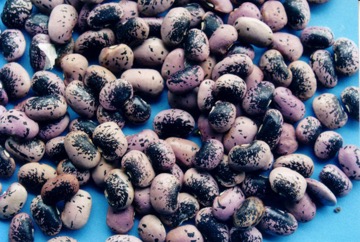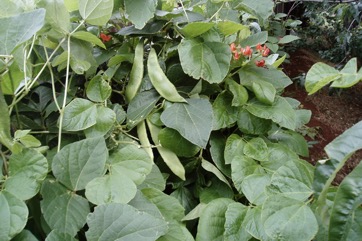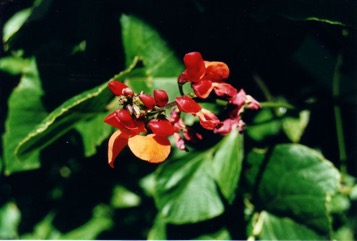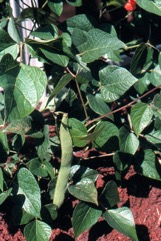Scarlet runner bean

A tropical plant. It grows naturally in the mountain regions from Mexico to Panama. It is grown in the highlands in the tropics. On the tropical coast seedlings die and pods are not formed. It is damaged by frost. It suits hardiness zones 8-10. In Sichuan and Yunnan.
Also known as:
Ayacote, Botil, Chamborote, Chilipuca, Cub, Cubaces, Dau son, Dutch caseknipe bean, Ejote, Fagioli rampicante di Spagna, Frijol chamborote, Hana mame, Haricot d'Espagne, Kacang besar, Koto moruk, Laški fižol, Patol, Poroto chileno, Seven year bean, Shim
Synonyms
- Phaseolus multiflorus Willd.
- Phaseolus coccineus var. zongolicensis Freytag, nom. inval.
- Phaseolus multiflorus Lam.
Edible Portion
- Seeds, Pods, Leaves, Roots, Vegetable
Where does Scarlet runner bean grow?
Found in: Africa, Argentina, Asia, Australia, Bangladesh, Britain, Canada, Caribbean, Central Africa, Central America, Chile, China, Colombia, Congo, Cook Islands, Costa Rica, East Africa, East Timor, El Salvador, Ethiopia, Europe, Fiji, Guatemala, Honduras, India, Indochina, Indonesia, Japan, Kenya, Korea, Madagascar, Mauritius, Mexico, Netherlands, New Zealand, Nigeria, North America, Pacific, Pakistan, Panama, Papua New Guinea, PNG, Philippines, Russia, Rwanda, SE Asia, Serbia, Slovenia, South Africa, Southern Africa, South America, Tanzania, Tasmania, Timor-Leste, Turkey, Uganda, United States, Vietnam, West Africa
Status: It is a commercially cultivated vegetable. Only occasionally grown in Papua New Guinea. The fleshy roots are an important food in Mexico.
Growing Scarlet runner bean
Cultivation: It is grown from seeds. Seed are planted 2.5 cm deep. Plants are spaced 20 cm apart. It needs sticks to climb up. It can be allowed to re-grow from the tubers or the tubers re-planted.
Edible Uses: The very young pods can be eaten. They are boiled, steamed, baked etc. The seeds are edible. They are dried then soaked. The flowers have a bean like flavour and are used in salads. Young leaves can be used as a potherb. The tubers can be eaten after they are cooked and the cooking water thrown away.
Production: It grows quickly.
Nutrition Info
per 100g edible portion| Edible Part | Energy (kcal) | Protein (g) | Iron (mg) | Vitamin A (ug) | Vitamin c (mg) | Zinc (mg) | % Water |
|---|---|---|---|---|---|---|---|
| Seeds | 339 | 20.3 | 9 | Tr | 7 | - | 12 |
Scarlet runner bean Photos




References
Bianchini, F., Corbetta, F., and Pistoia, M., 1975, Fruits of the Earth. Cassell. p 34
Brink, M., 2006. Phaseolus coccineus L. [Internet] Record from Protabase. Brink, M. & Belay, G. (Editors). PROTA (Plant Resources of Tropical Africa), Wageningen, Netherlands. < http://database.prota.org/search.htm>. Accessed 21 October 200919 October 2009.
Burkill, I.H., 1966, A Dictionary of the Economic Products of the Malay Peninsula. Ministry of Agriculture and Cooperatives, Kuala Lumpur, Malaysia. Vol 2 (I-Z) p 1739 (As Phaseolus multiflorus)
Burnie, G.(Ed.), 2003, Annuals and Bulbs. The Gardener's Handbooks. Fog City Press. p 208
Cheifetz, A., (ed), 1999, 500 popular vegetables, herbs, fruits and nuts for Australian Gardeners. Random House p 87
Cruz, I. M., et al, 2015, Edible fruits and seeds in the State of Mexico. Revista Mexicana de Ciencias Agricolas. Vol. 6. Num. 2 pp 331-346
Cundall, P., (ed.), 2004, Gardening Australia: flora: the gardener's bible. ABC Books. p 1022
Evans, A.M., 1979, Beans, in Simmonds N.W.,(ed), Crop Plant Evolution. Longmans. London. p 168
Facciola, S., 1998, Cornucopia 2: a Source Book of Edible Plants. Kampong Publications, p 109
FAO, 1993, Valor Nutritivo Y Usis en Alimantacion humana de Algunis Cultivos Autoctonos Subexplotados de Mesoamerica. FAO, Santiago, Chile. p 103
Farfan, B., et al, 2007, Mazahua Ethnobotany and Subsistence in the Monarch Butterfly Biosphere Reserve, Mexico. Economic Botany 61(2) 2007, pp 173-191
French, B.R., 1986, Food Plants of Papua New Guinea, A Compendium. Asia Pacific Science Foundation p 48
Hedrick, U.P., 1919, (Ed.), Sturtevant's edible plants of the world. p 480 (As Phaseolus multiflorus)
Hermandez Bermejo, J.E., and Leon, J. (Eds.), 1994, Neglected Crops. 1492 from a different perspective. FAO Plant Production and Protection Series No 26. FAO, Rome. p18, 48
http://www.botanic-gardens-ljubljana.com/en/plants
Hu, Shiu-ying, 2005, Food Plants of China. The Chinese University Press. p 479
ILDIS Legumes of the World http:www:ildis.org/Legume/Web
Jardin, C., 1970, List of Foods Used In Africa, FAO Nutrition Information Document Series No 2.p 28
Kapelle, M., et al, 2000, Useful plants within a Campesino Community in a Costa Rican Montane Cloud Forest. Mountain Research and Development, 20(2): 162-171
Kays, S. J., and Dias, J. C. S., 1995, Common Names of Commercially Cultivated Vegetables of the World in 15 languages. Economic Botany, Vol. 49, No. 2, pp. 115-152
Kiple, K.F. & Ornelas, K.C., (eds), 2000, The Cambridge World History of Food. CUP p 1729
Lazarides, M. & Hince, B., 1993, Handbook of Economic Plants of Australia, CSIRO. p 187
Lim, T. K., 2015, Edible Medicinal and Non Medicinal Plants. Volume 9, Modified Stems, Roots, Bulbs. Springer p 65
Macmillan, H.F. (Revised Barlow, H.S., et al) 1991, Tropical Planting and Gardening. Sixth edition. Malayan Nature Society. Kuala Lumpur. p 328, 360
Martin, F.W. & Ruberte, R.M., 1979, Edible Leaves of the Tropics. Antillian College Press, Mayaguez, Puerto Rico. p 45, 200
Moerman, D. F., 2010, Native American Ethnobotany. Timber Press. p 390
Molares, S. & Ladio, A., 2012, The Usefulness of Edible and Medicinal Fabaceae in Argentine and Chilean Patagonia: Environmental Availability and Other Sources of Supply. Evidence-Based Complementary and Alternative Medicine. Volume 2012, Article ID 901918, 12 pages, Hindawi Publishing Corporation.
Pena, F. B., et al, 1998, Los quelites de la Sierra Norte de Puebla, Mexico: Inventory Y Formas de Preparacion. Bol. Soc. Bot. Mexico 62:49-62
Pham-Hoang Ho, 1999, An Illustrated Flora of Vietnam. Nha Xuat Ban Tre. p 963
Plants for a Future database, The Field, Penpol, Lostwithiel, Cornwall, PL22 0NG, UK. http://www.scs.leeds.ac.uk/pfaf/
PROSEA
Purseglove, J.W., 1968, Tropical Crops Dicotyledons, Longmans. p 294
Shaheen, N., et al, 2013, Food Composition Table for Bangladesh. University of Daka. p 21
Terra, G.J.A., 1973, Tropical Vegetables. Communication 54e Royal Tropical Institute, Amsterdam, p 65
Tindall, H.D., 1983, Vegetables in the Tropics, Macmillan p 276
Tronickova, E. & Krejcova, Z., 1987, Ortaggi, Instituto Geografico de Agostini, Cecoslovacchia. p 126
USDA, ARS, National Genetic Resources Program. Germplasm Resources Information Network - (GRIN). [Online Database] National Germplasm Resources Laboratory, Beltsville, Maryland. Available: www.ars-grin.gov/cgi-bin/npgs/html/econ.pl (10 April 2000)
van Wyk, B., 2005, Food Plants of the World. An illustrated guide. Timber press. p 288
Verdcourt, B., 1979, Manual of New Guinea Legumes. Botany Bulletin No 11, Division of Botany, Lae, Papua New Guinea. p 512
http://cookislands.bishopmuseum.org